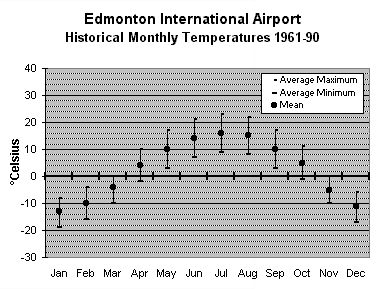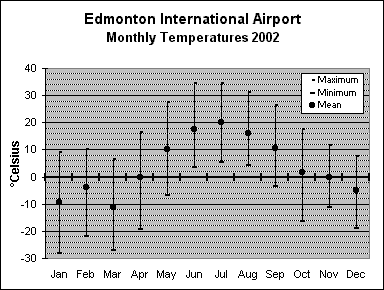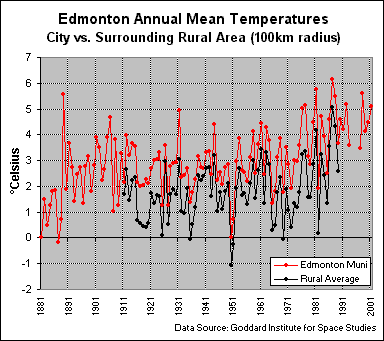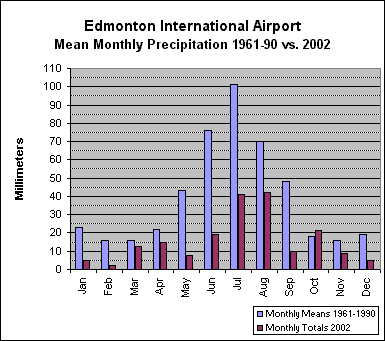
 |
Weather
-
The calculations done by General Circulation Models (GCMs) are
the main source of the information that fuels the global warming hysteria.
Nevertheless, not one of them comes acceptably close to accurately calculating
what the climate presently is at any location, let alone of the whole Earth.
Not only that, but all of the GCMs differ widely from one another as to what the
climate was in the past, and as to what it is supposed to be in the future.
Therein lies the problem. No one in his right mind will base any decisions
about the future on tools that cannot determine with acceptable accuracy what
the present is and the past was.
Current Conditions and Weather Forecasts by The Weather Network
Canada,
Northern
Alberta (click on the area of the map you are interested in)
Edmonton
Area
-
Station(s) of the Week
(annual mean temperatures from varying rural locations in the world, courtesy
John. L. Daly)
-
Temperature
Record of the Week (annual mean temperatures from one of the
U.S. Historical Climatology Network (USHCN)
stations from 1930-2000; presented by the Center for the Study of
Carbon Dioxide and Global Change) -
Variability over time of forecasts
issued for a given day by The Weather Network
2003 07 21 to 2003 07 29
Are long-range weather forecasts reliable enough to permit you to plan your
haying operation? You wish, but it is apparently better for you to rely on your own
judgment when making weather forecasts. Mind you, if you could cut, bale and bring
the hay in all in one day, then the forecasts issued on a given day for that day are not
all that bad.
Accurate forecasts for the next seven days in advance? Forget it!
You'll be better off to bet on the horses.
-
Historical Monthly Temperatures at the
Edmonton International Airport
-
2002 Temperatures at the Edmonton
International Airport
-
Annual mean temperatures in
Edmonton
vs. surrounding rural area (1881-2001)
-
Precipitation at the Edmonton
International Airport — Comparison of 1961-1990 averages to monthly totals
in 2002
-
Weathering farming in 2002
-
Seasonal Forecast Verification 2001-
2002 for all of Canada
-
Weather reports that the global-warming
alarmists rather would neither have published nor read
More current weather reports at
John L. Daly's website
December, January and February: 1971 to 2000,
March, April and May: 1971 to 2000,
June, July and August: 1971 to 2000 and
September, October and November: 1971 to 2000
Solar flares cause beautiful displays of northern lights, especially and
more frequently at high latitudes. However, they also cause fluctuations in
geomagnetic fields that are of concern to power companies and consumers of electricity, as
they will generate voltage fluctuations in power grids. The strength of those
fluctuations can range from weak voltage fluctuations with geomagnetic storms of G1 scale
to serious voltage control problems, system collapse, blackouts and transformer damage to
small and large transformers alike with storms of G5 scale.
The U.S. Space Environment Center (SEC) distributes
Space Weather Advisory
information via email. See
instructions
for subscribing to, or unsubscribing from, their email list. If you are an avid
watcher of northern lights, you may wish to subscribe. That way you will be able to
get ready in time to watch or even to take photos.

Source:
The Weather
Network
The values for the historical maximum and minimum temperatures shown in
the preceding graph are 30-year averages for the 1961 - 1990 interval. The
temperature range shown for each month does therefore not reflect the extreme values
reached in anyone month during that interval, although those extremes are accounted for in
the average values shown.
The following graph for 2002 shows what the actual extremes were during every
month in that year.

Source: The Weather Network:
FarmZone Edmonton For the rural areas surrounding Edmonton, temperature records from the Edmonton
International Airport are more representative than Edmonton's temperature records.
The city of Edmonton produces a heat-island effect. It is generally a few degrees
warmer in Edmonton than in the surrounding rural areas.

The preceding graph is based on temperature data collected by the Goddard Institute for
Space Studies. The average mean temperatures for the
rural
area surrounding Edmonton were calculated from the records for the weather stations
that exist or existed in a 100 km radius from Edmonton during the past 122-year interval.
The calculations done by General Circulation Models (GCMs) are
the main source of the information that fuels the global warming hysteria.
Nevertheless, not one of them comes acceptably close to accurately calculating
what the climate presently is at any location, let alone of the whole Earth.
Not only that, but all of the GCMs differ widely from one another as to what the
climate was in the past, and as to what it is supposed to be in the future.
Therein lies the problem. No one in his right mind will base any decisions
about the future on tools that cannot determine with acceptable accuracy what
the present is and the past was.
Update 2009 12 11:
The GISS temperature record can no longer be
trusted.
On or around about Nov. 14, 2009, GISS began to use a
new global temperature data set that deleted temperature records relating to
the late 19th and early 20th centuries. Not only that, but the
temperature data that remained in use were adjusted downward for dates
preceding the year 2000 (increasingly downward the farther back in the
temperature record they go), thereby creating or exaggerating "warming"
trends for individual locations.
A discussion thread at
http://wattsupwiththat.com details the nature of the data fiddling.
From that discussion thread:
...See under “What’s New”:
http://data.giss.nasa.gov/gistemp/graphs/
“Nov. 14, 2009: USHCN_V2 is now used rather than the older
version 1. The only visible effect is a slight increase of the US
trend after year 2000 due to the fact that NOAA extended the TOBS
and other adjustment to those years.
Sep. 11, 2009: NOAA NCDC provided an updated file on Sept. 9 of the
GHCN data used in our analysis. The new file has increased data
quality checks in the tropics. Beginning Sept. 11 the GISS analysis
uses the new NOAA data set. ”
The "visible effect" of the new, manipulated data set is far greater than
the quoted note implies. The data changes were without a doubt
manufactured to create a warming trend where none exists or to exaggerate
possibly existing warming trends.
This is not the first time that the gate keepers of climate data were caught
in the act of large-scale falsifying of existing data.
Note that the record of the mean temperatures for Edmonton shows a rising
trend in the late 19th century. Most of that temperature increase is due to global
warming, as the Earth was just coming out of the Little Ice Age
of that time. A relatively small, insignificant and slightly increasing portion of
the temperature increase during that time was due to Edmonton's rapid growth from a small
town to an increasingly larger city with the accompanying increase of local heating.
There are no permanent weather stations in the County of Lamont. The nearest
weather stations that are, or better, were located in rural
areas, were in Lacombe,
Radway,
Forestburg,
Halkirk
and Lloydminster.
Temperatures and other weather data had been recorded, for example, in
Lacombe from 1907 to 1990 Radway from 1922 to 1951 Forestburg from 1967 to 1989 Halkirk from 1907 to 1929 Lloydminister from 1913 to 1970
Check the temperature records for those stations to see whether you should lay in some
money for an air conditioner or set up a wood lot to give you a supply of firewood in case
you can't afford the increasing costs of fossil fuel anymore.
None of those stations are operational anymore. If our Federal Government is
concerned about global warming, it sure has an odd way of expressing it. More and
more weather stations are being closed down, perhaps because we can now rely on satellite
data. However, the satellite data show no global warming. They show, just as the
data from many ground-based weather stations in rural areas of the world, that
temperatures are cooling off or at best in some locations are increasing by almost
imperceptibly small amounts. That is born out by many other sources of information,
such as those identified by Dr. Theodor Landscheidt
from the Schroeter Institute for Research in Cycles of Solar Activity, Nova Scotia,
Canada.
So, what is it with the global warming hype? And what about the Kyoto Accord
that is being rammed down our throats? Are we supposed to take Jean Chretien's word
for it that we need the accord to be able to survive? He also told us that he would
"kill de GST."

Source: The Weather
Network
Weathering farming in 2002
In the morning of April 14, 2002, after we finally had four days of
weather warm enough to melt most of what little snow we had received during the winter,
the temperatures began to drop. Then it rained, and then the rain turned to
snow. The moisture was sure welcome, but it put a halt on seeding operations.
The hopes that the fields would soon be dry out enough so they could be worked were
eventually fulfilled, but then there was not enough rain or warm weather to make the crops
grow. When it did become warm enough, much of the moisture received had already
evaporated and the portion of crops that had germinated ripened within a few days.
What had not germinated made a late start and began too sprout, far too late to ripen in
time. Moreover, the large volumes of second growth often did not ripen sufficiently
to produce a viable, mature crop and interfered with the harvesting operations. Many
fields contained stands of crop with large portions that lagged behind with growing by a
few weeks and often as much as two months.
Some farmers had not finished seeding. They didn't bother anymore to
put the crops in that still had to be seeded. That was the best thing to do under
the circumstances. The crops that had been put into the ground were slow to germinate or
didn't germinate at all. When the weather became warm enough to do any good, there
was not enough rain to make anything grow, and even under the best of circumstances, the
rain and warm weather did not come in time to do much good anymore.
Finally, in July and in August of 2002, there was a reasonable amount
of rain. By then it was too late. There was little forage to harvest.
The pastures had been eaten down and did not produce enough to sustain the cattle.
Many farmers had to begin to haul water or increase the number of trips to keep up.
Farmers began to sell off cattle and other livestock. Cattle inventory and prices
dropped.
The quality and quantity of the crops harvested were way below even of those
of the crops harvested in the terrible year of 2001. Many farmers did not bother to
combine. They just baled or cut for silage as much as they could, hoping in vain to
recover the cost of seeding. For most, all they got back was a very small fraction
of their input costs, and the values of what was harvested often did not even cover the
cost of the harvesting.
No federal help was forthcoming other than the promise of a contribution in
the order of eight dollars per acre for cropland that had cost $140 or more per acre to be
seeded. That contribution did not even target the areas most affected by the
drought. The total amount of the one-time federal drought subsidy is about in the
order of what it will cost annually to maintain and operate Jean Chretien's firearms
registry scam. Farmers rank so low on the Liberal's priority list that perhaps they
are not even on it.
There is no help for farmers other than the advice by some people, including
Jean Chretien, that farmers need to tighten their belts, and that they should look for
more profitable endeavors. That may be heartless, but it appears to reflect how our
leader feels about things. He has said many times that anybody who thinks that the
Canadian Liberal government is not doing a good job can always leave and go elsewhere,
"it is a free country." Some help for farmers that is, but there is Jean
Chretien eager to have Canada commit itself to contribute to and even lead by its lonesome
self the efforts to curb the largely nonexistent global warming.
It is generally recognized that there will be only great costs and no
net-benefits to Canada from that and that any efforts to curb "man-made" global
warming will be futile even if all countries in the world were to cooperate with Canada's
efforts – which they won't. Nevertheless, Jean Chretien pushes ahead anyway
with Maurice Strong's and David Suzuki's agenda for equalizing Canada's wellbeing with
that of the lesser developed nations, even though the hair-brained scheme hasn't been and
will not ever be discussed by our elected representatives in Parliament. Canada's
Leader can and does make the decisions required to further his dreams without the approval
of our elected representatives, although, given that his party holds an absolute majority
in Parliament, approval is virtually guaranteed if appearances need to be upheld and any
issues should come to a vote.
Some political analysts speculate that Jean Chretien hopes to gain enough brownie-points with the leaders of lesser developed
nations so as strengthen his chances to be appointed as a replacement for Kofi Anan as
the UN Secretary General. We will all have to pay for that dream, although it will
almost certainly not materialize, not even for Jean Chretien.
In the meantime, the Sun will continue to drive and control our global
climate changes as it has done since billions of years before man even made an appearance
on Earth.
Seasonal Forecast Verification
2001- 2002Observed and
forecast temperatures for Canada (maps):
"Normal" is the 1963-1993 mean temperature for a given region.
Observed
and forecast precipitation for Canada (maps)
"Normal" is the 1960-1990 mean precipitation for a given region.
Weather reports that the
global-warming alarmists rather would rather neither have published nor read:
Russian
freeze traps ships
BBCi, 2003 01 09
Severe winter weather in Russia has trapped about 40 ships in the icy Gulf of
Finland....240 people...have frozen to death in Moscow since the beginning of
winter....six people froze to death overnight....10 people died from cold and 66 were
hospitalized with frostbite over the Orthodox Christmas holiday.
Baltic
Sea has most extensive ice cover in decades
Helsingin Sanomat, 2003 01 08
Thanks to the cold weather of recent weeks, the ice cover along the Finnish
coasts is more extensive than in decades...the whole Baltic Sea could freeze over all the
way to the Straits of Denmark, for the first time since 1948....Not even the occasional
milder spells will necessarily help....covering an unusually large area, the ice is also 5
- 20 centimetres thicker than average....there surely will be problems in keeping the
routes open. The worst possible situation would be if the ice starts seriously packing up,
forming high barriers....Seven of Finland's nine icebreakers are already at sea, and the
remaining two are preparing to go....Dozens of ships are waiting for help from icebreakers
outside the ports of St. Petersburg and the Estonian capital Tallinn....
Cold wave cuts swath of
misery and death
International Herald Tribune, France, by
Barry
James
Friday, January 10, 2003
An exceptional cold wave - the worst in more than a decade in many regions -
continued to spread misery, disruption and death across Europe on Wednesday and held a
large part of Asia in an icy grip, killing scores of people in India and Bangladesh.
...Another three people were found frozen to death in the streets of cities, bringing the
total to at least 240 since the cold spell started....in Moscow...about 30 people have
died since the beginning of the current cold wave....Icebreakers worked to open a path for
about 40 ships stranded outside the port of Saint Petersburg, where trains full of oil,
metals and coal were waiting to unload their cargoes....Meteorologists said there was a
danger that the Baltic Sea could freeze solid. Thousands of people in southwestern Sweden
were without drinking water because pipes froze....The situation was the same in
Lithuania, where temperatures hit a 16-year low and three people were found dead on the
streets. Schools in Poland were forced to close....the National Weather Service in the
United States....said the unusual weather would continue at least through the
spring.....about 400 people have died of exposure in Bangladesh and northern
India....Chinese authorities used explosives to break up huge ice dams on the Yellow River
to prevent water accumulating upstream and overflowing....thick ice covered more than
1,200 kilometers (750 miles) of the 5,400-kilometer river.....
More current weather reports at John
L. Daly's website
___________________See also:
Global Warming
Daydream believer: Our prime
minister appears to be angling for the top UN post, by Peter Stock, The
Report Newsmagazine, 2002-11-04
It's time someone
asked: Is our prime minister undergoing a complete mental breakdown?, by
Ted Byfield, The Report Newsmagazine, 2002-10-07, Westview
The energy wars erupt
again: Jean Chretien vows to battle Alberta and oppose the U.S. over the Kyoto climate
treaty. All Canadians will pay the price, by Mike Byfield, The Report
Newsmagazine, 2002-09-23, COVER STORY
The following is not part of Lorne Gunter's
article:
Why Canada promotes the
implementation of the Kyoto accord.
The Kyoto Accord is ostensibly intended to curb or reduce man-made global
warming. Realistically, the Kyoto accord will do no such thing.
At worst, man-made contributions through combustion of fossil fuels causes a
maximum of one third of the warming experienced in the northern hemisphere.
All or most of the warming that we have experienced since the globe climbed
out of the Little Ice Age is caused by long-term variations in the amount of
solar radiation....
At the very least, the Kyoto accord will bring serious harm or perhaps
even ruin to the economies of the developed nations. The collapse of
the developed nations will lead us into a new dark age for the world.
Still, powerful and influential individuals have been at work for many years
to implement exactly that sort of design for the future of humanity. (Full
Story)
__________________
Posted 2002 04 14
Updates:
2002 12 27 (updated links to the the Parks Canada web page for Elk Island Park and added
links for seasonal forecast verification))
2003 01 06 (page extensively rewritten to provide statistics and more links to
current and historical weather information in addition to a summary of the impact of the
weather on farming in 2002 in Central Alberta)
2003 01 09 (added weather reports about record cold-snap in
Europe and Asia)
2003 03 17 (added link to Space Weather Advisories)
2004 03 08 (added more links to related articles) |



